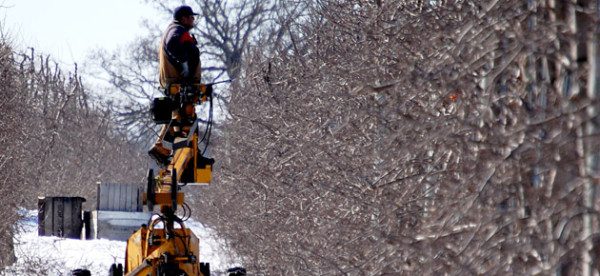

Jan 3, 2011Pruning high-density orchards
Modern high-density orchard systems such as the tall spindle are based on simple pruning concepts that include minimal pruning in the early years and limb-renewal pruning at maturity.
Pruning is always a matter of compromise, since pruning has both positive and negative effects. The benefits of proper pruning include improved light penetration into the canopy, containment of tree size, renewal of bearing surface and improved spray penetration into the canopy.
Young trees
One of the most significant differences between the tall spindle and the more traditional central-leader tree management is that the tree is not headed at planting, whether it is a whip or a feathered tree. The lack of heading allows development of a tall and more slender tree more quickly, and also results in earlier flowering – since pruning delays flowering.
Another of the important techniques is limb bending. When limb bending is combined with the lack of heading in young trees, significant early cropping can be achieved in the second year. With the tall spindle, all of the feathers should be tied or weighted below the horizontal soon after planting to induce cropping and prevent them from developing into substantial lower scaffolds. The pendant position results in a weak fruiting branch instead of a scaffold branch.
This simple change in tree management allows for long-term cropping of many feathers and little invasive pruning for the first five years. After the initial tying or weighting down of feathers at planting, new lateral branches that arise along the leader do not need to be tied down. In most climates, if moderate vigor lateral shoots arising along the leader are not pruned, they will bend below horizontal in the third year and a natural balance between vigor and cropping will be established without additional limb positioning.
Mature trees
When tall spindle trees pass year five, they are considered mature; a simple repetitive pruning process of limb renewal is implemented which is fast, has a minimal number of cuts, results in good light distribution and is easily taught. The tall spindle is essentially a 10-foot trunk with small fruiting branches inserted all along its length.
The basic tree structure can be developed in only three years, since the central leader is not cut (headed) at planting. The pruning of the tall spindle tree can be simplified into three steps.
Limiting tree height. The leader is not headed at planting or for the first 4-5 years until mature tree height has been achieved. Usually, in year six – after heavy cropping in the top has begun – the leader is cut annually to a small side branch at the optimum height, where light interception is maximized without causing excessive shading of the lower canopy. Our experiments have shown this height to be about 90 percent of the between-row distance.
Branch caliper management. When a lateral branch in the tall spindle tree gets too long or too big in diameter, it is removed – allowing a smaller replacement branch to develop. To limit the negative effects of pruning on vegetative vigor, we limit the number of branches to be removed each year to just two. However, if this is repeated annually the tree never develops any large branches and continues from an early to an old age to have only small fruitful branches, which give the tree a narrow, slender shape.
To assure the development of a replacement branch, the large branch should be removed with an angled or beveled cut so that a small stub of the lower portion of the branch remains. From this stub a flat, weak replacement branch often grows.
After trees reach maturity, lower branches, including some of the original feathers, become too large and are systematically removed. As the trees age, the top of the tree tends to overgrow the bottom. To prevent this problem and to maintain good light distribution and good fruit quality, the top of the tree must be kept narrower than the bottom of the tree. Maintaining a conic shape as the trees age is critical to maintaining good light exposure and fruit quality in the bottom of the tree.
A successful approach to managing the tops of trees has been to annually remove one to two of the larger upper branches using a bevel cut. If the replacement shoots, which arise from these cuts, are left unheaded they will naturally bend down with the crop. When this style of pruning is repeated annually, the top of the tree can be composed completely of young fruitful branches. The younger branches do not cause as much shade as larger, older branches, and are naturally shorter than the bottom branches – thus maintaining the conic shape of the tree.
Columnarizing or simplifying the fruiting branches. The remaining branches in the tree should be columnarized or simplified (secondary side branches larger than one half of the diameter of the branch should be removed, leaving each branch as a long fruiting column) to improve fruit coloring.
A columnar branch covered with spurs and fruit will cast less shade on the lower part of the tree than a complex branch. When columnarized branches become too long or too large in diameter, they are removed through the annual removal of one to two large branches per tree.
The key objectives for a new high-density orchard are to maximize yield in the early years and still efficiently produce large yields of high-quality fruit after the trees are mature. Since large branches contribute to the development of large trees, the tall spindle trees – which have no large scaffold branches – remain small and easily managed for many years.
The removal of whole branches instead of heading back branches helps limit the adverse effects of pruning on tree vegetative vigor while maintaining a balance of vegetative growth and cropping. Although these principles apply specifically to the tall spindle system, they can be applied to all other apple growing systems.
– Terence Robinson, Cornell University














